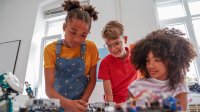Building a Learning Community From Day One
Teachers can foster a learning network in the classroom by focusing on strategies that lead students to work closely together.
Your content has been saved!
Go to My Saved Content.Learning communities connect educators to a larger network that can help us grow personally and professionally through a system of support. We can provide a similar opportunity for the students in our classrooms: Establishing connections among learners helps develop collaboration skills that are essential for their future success.
They become more comfortable in their learning space, build confidence working with and sharing their knowledge with classmates, and develop essential social and emotional learning (SEL) skills. Fostering this type of learning environment should begin at the start of the school year and be a consistent and intentional focus each day.
Creating spaces for students to collaborate
At the beginning of each school year, educators can start with icebreakers and use class activities to get to know their students better and help students to learn about and connect with one another. Even if students have been classmates for years, as happens in small schools, it doesn’t mean that they really know a lot about one another. Fostering the development of SEL skills, especially in building relationships and social awareness, will prepare students for their future.
Our work is in finding the right methods and tools so students can build these skills while also having the space to design their own learning path as they collaborate in and out of the classroom. We want them to develop their skills in independent learning while also becoming comfortable in asking for help and providing support to classmates. These skills transfer to any area of work, and learning that will benefit them now and in the future.
In my own classroom this year, I noticed a decrease in student engagement as the year went on. Students were not working well together, and the relationships were not always positive. I tried to bring in new methods to improve these areas, focusing particularly on relationship-building and fostering SEL.
Learning stations: My first risk was starting with learning stations, which was an entirely new experience for me. When used in the classroom, learning stations not only open up more possibilities for personalized learning but also help students to work on their social interactions and build relationships with classmates and their teacher. Using between three and five stations in the classroom, depending on class size and grade level, teachers can have students work together through a series of learning activities. Selecting a mix of digital tools, hands-on learning activities, and teacher-directed instruction creates a good mix of ways for students to engage with the content.
In learning stations, I noticed students teaching each other, exchanging ideas, and stepping in to help classmates that they had never really spoken with before. After a few weeks, students commented on how much more they enjoyed class. After two months, they said they felt like they were a part of a learning community. They enjoyed the experience and felt like they had a class family to learn with. Hearing these words from my students was huge.
In learning stations, providing hands-on activities and challenges that require students to work together, problem-solve, and create is important. Using digital tools like a breakout game or escape room, creating an interactive lesson using Nearpod, or using of a discussion board such as Padlet can be great options for facilitating learners’ interactions. Collaborative discussion boards where students can post comments and respond to classmates or a space like Wakelet where they can interact work very well.
For boosting speaking skills and to get them talking in and out of the classroom, use Flip and give students a prompt to discuss. At a learning station, students can record a group response or even connect with other students from classrooms around the world, and extend their learning community to a global scale.
Cross-curricular collaboration: Finding ways to connect learning beyond our content area is also important.
Here are some tips to make this go well:
- Find a colleague to work with and create a task that the students in both of your classes must collaborate on.
- Choose a method like project-based learning (PBL) for the task—this step clearly involves a lot of work, but it’s worthwhile.
- Set up a way for students to collaborate outside of the classroom and also a consistent time for you and your colleague to connect and reflect.
A few years ago in my eighth-grade STEAM course, I wanted to teach students about creating and collaborating on presentations. More than that, I wanted to connect them with their classmates beyond our physical classroom space. I decided to also expand my learning community and work with one of the science teachers on a cross-curricular project. For our first collaboration, I connected with an eighth-grade science teacher, and our students used Buncee to create their presentation. The focus was on an air-quality project, and they had to come up with solutions to challenges and then, with each student in the group having a task, provide information to add to the Buncee.
After seeing the impact of this project on student collaboration, I decided to bring this into my Spanish classes as well, to foster essential SEL skills. My students connected with students from Argentina and Spain, and taught each other about their backgrounds, interests, cultural and family traditions, and other aspects of their lives by leveraging technology tools to exchange information.
As educators, it is essential that we continue building our professional skills by making connections that will support us in growing. We need to create the same opportunity for our students to collaborate with one another and spark their interests in different areas. When we work to establish learning communities for our students, they will become more comfortable and confident, and know that they are cared about and empowered in their learning journey.
